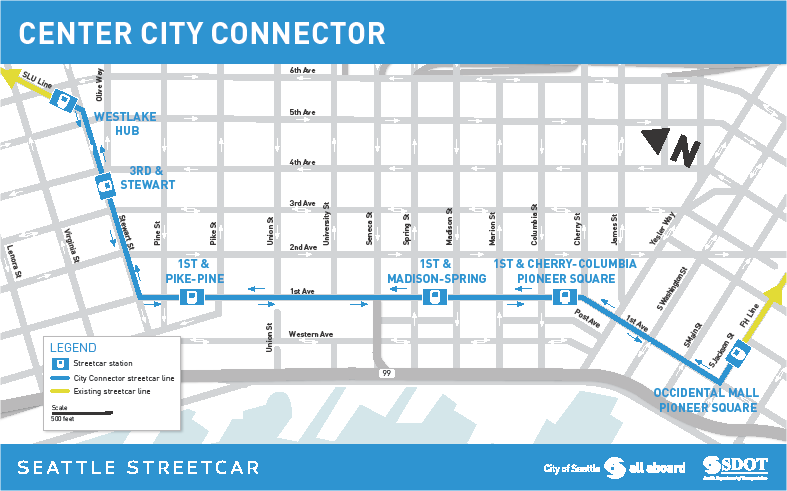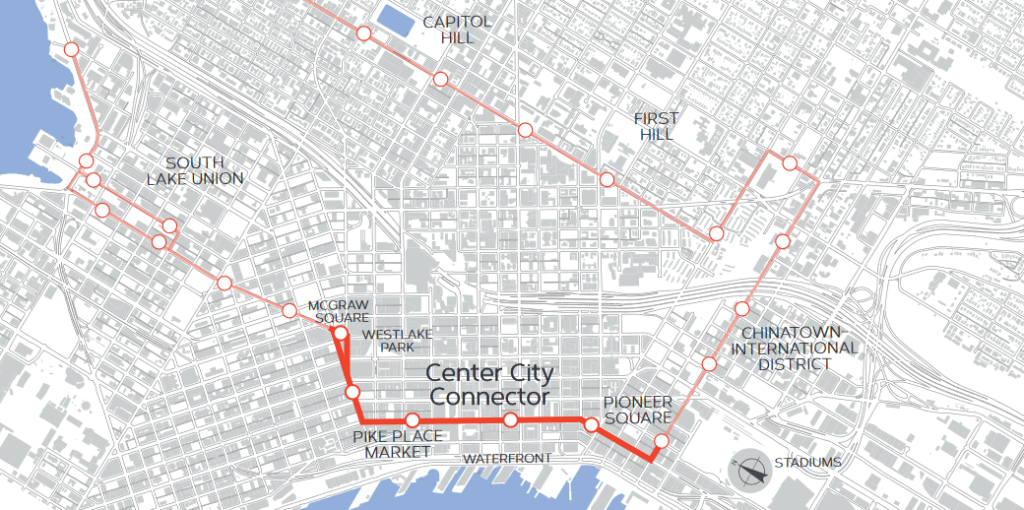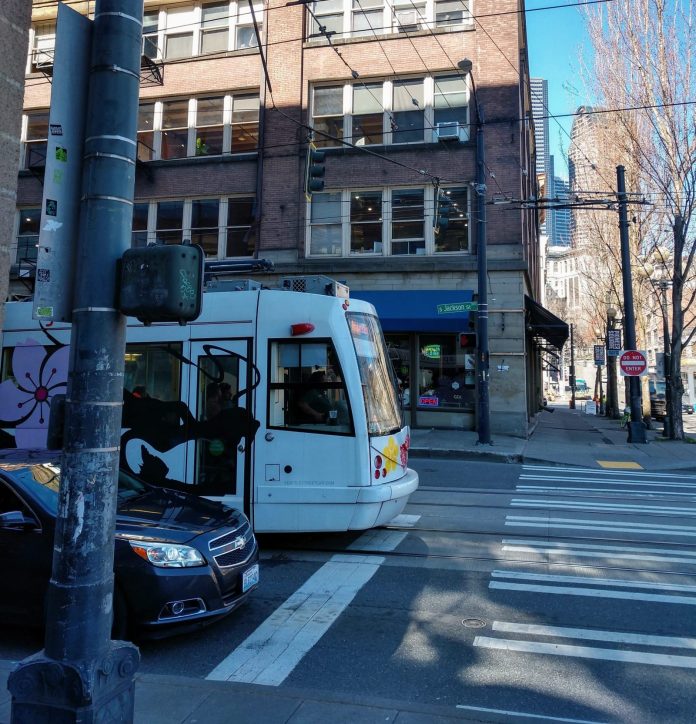On Tuesday, the Seattle City Council’s transportation committee will consider a proposal to continue work on the Center City Connector by authorizing $9 million in engineering work. The proposed funding mechanism is an inter-agency loan from the Information Technology department, backed potentially by proceeds from the sale of the Mercer Megablock.
Seattle Department of Transportation (SDOT) Director Sam Zimbabwe will be on hand at the meeting to present a 2018 streetcar operation report on the existing lines and make the appropriation request. The $9 million appropriation does not represent a new budget item, but rather part of the revised budget SDOT presented in January. Ultimately, SDOT estimates a $65 million budget shortfall must be closed to make the $207 million streetcar project and $78 million in utility work happen.
The Seattle Streetcar Coalition is rallying folks to attend and testify at the 2pm meeting at City Hall to show support for the beleaguered project (which has been in limbo since Mayor Jenny Durkan halted work amid budget worries). Before the delay, the project was slated to open in mid-2020, but the new timeline targets a 2026 opening.
In making its case, SDOT has stressed that ridership on the First Hill Streetcar is up 31%. Overall, streetcar ridership topped 1.7 million rides in 2018. I talked to Director Zimbabwe on Friday to get a preview of his presentation.
“Ridership has been strong on the streetcar overall. It’s been a little flat on South Lake Union, but very strong on the First Hill line,” Zimbabwe said. “We’re excited about that. There’s still good issues to work on to improve service on South Lake Union. We’re doing some speed and reliability improvements.”
Those improvements include red paint transit lanes and signs that SDOT hopes will keep motorists from impeding the streetcar.
The Center City Connector would extend the First Hill Streetcar and link to the South Lake Union Streetcar, making one unified line projected to attract about 20,000 daily riders basically as soon as it opens. That’s more than the busiest bus in Seattle.

South Lake Union ridership was down 4% in 2018, likely dragged down by a continued drop in reliability due to heavy congestion and by competition from buses like the RapidRide C and Route 40 that use the same corridor and also benefit from the same transit lanes. Just 39% of South Lake Union streetcar trips were reliable, SDOT said–defined as within five minutes of the scheduled time–whereas the First Hill Streetcar’s reliability increased to a new high of 88% in 2018. Both lines are seeing increased ridership in the first quarter of 2019, SDOT reported.
The Center City streetcar project did appear shovel ready in 2018, but the appropriation would pay for a few upgrades ironing out kinks in the plan. One major item is bridge strengthening of Jackson Street between Third Avenue and Fifth Avenue. The heavier new streetcars running on the existing tracks would otherwise overburden the aging bridge there. Another item is altering the maintenance barn to fit the longer streetcars the Connector will use. There also remains a little bit of station work to make the older stations compatible with newer vehicles.
The appropriation will run into opposition in the form of Councilmember Lisa Herbold, who has been highly critical of the project and dismissive of any benefits it could bring. Heidi Groover reported that Herbold referred to the $75 million in federal grants the streetcar is in line for as “speculative” and called the $9 million loan “good money after bad.” Whether any of her eight colleagues agree with that hard-line stance remains to be seen. Most ($50 million) of the “speculative” federal grants had already been secured, which is only complicated by potentially needing to re-apply due to the delay in construction.

While Councilmember Herbold has argued the streetcar is an economic development gimmick, Director Zimbabwe emphasized its transportation value. “It’s a project we think is very valuable from a transportation perspective,” he said. “We see the streetcar as an important part of the future transportation network in the Center City… It’ll be a complimentary use and not redundant.”
That value will only increase as major investments (like the new Seattle Waterfront Park) come online near the streetcar route.
“As the viaduct has started to come down, you really feel how much closer First Avenue is now to the Waterfront,” Zimbabwe said. “It feels like you’re almost right there, whereas Third [Avenue] still feels more removed.”

Interconnectivity, especially to light rail, has been a major driver of the surge in First Hill Streetcar ridership, Zimbabwe said, and that effect will only get greater as the Northgate Link Extension comes online in 2021 and East Link in 2023. Those light rail lines will attract more transit riders to the Center City where the streetcar helps them connect to adjacent destinations, such as the Waterfront or First Hill.
“Our leadership and the streetcar team are incredibly grateful for the time, energy and patience Seattle, the Streetcar Coalition and the Council has afforded the Department over the last year as it worked through an organizational re-alignment and adjustments to position the C3 project for success,” SDOT posted on its blog. “With new leadership and dedicated program and project teams, we are confident it can responsibly deliver the Center City Connector project. Seattle residents, businesses, and visitors deserve the best. And we are committed to giving its best in service to all.”
A majority of city council candidates at forums hosted by the MASS coalition said they support funding the completion of the line, a good sign as it seems very likely the next council will have a great deal of control over moving the project forward.
Strong community support is part of what has kept the streetcar alive through a turbulent 16 months. It’s best we keep that support and pressure up to ensure the city council holds fast rather than abandoning the streetcar to the dust-heap of Seattle’s transportation history–which is already filled with missed opportunities and miscues.
Doug Trumm is publisher of The Urbanist. An Urbanist writer since 2015, he dreams of pedestrian streets, bus lanes, and a mass-timber building spree to end our housing crisis. He graduated from the Evans School of Public Policy and Governance at the University of Washington in 2019. He lives in Seattle's Fremont neighborhood and loves to explore the city by foot and by bike.



